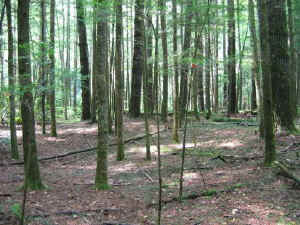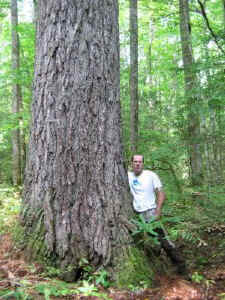Hello
ENTS!
This post is long in coming due to storm damage taking up much
of my power,
water, and nearly all my energy with regards to tree cleanup.
Hurricane
Frances dumped 18.75" of rain here in Black Mountain and
hurricane Ivan last
week hit parts of Buncombe County with winds over 90 miles per
hour and 6
more inches of rain. I learned that tree toppling appears to be
not due so
much to structural limits of the tree but of the soil. Anyway, I
have spent
many hours with a crane pulling trees off or out of houses the
last two
weeks, and am now hoping that Jeanne will be "nice" to
western North
Carolina. Flooding has been serious down here as I am sure many
of you have
heard.

(Pine Flats
- photo by Will Blozan)
Before hurricane Ivan, Jess Riddle and I were able to get into
Pine Flats,
an exceptional pine forest in the Great Smoky Mountain National
Park. The
grove is on lower Cataloochee Creek, NC, on an outwash (?)
terrace that may
be old sand bars from massive flood events. It is possible that
the grove,
which is nearly pure eastern white pine, initiated from such an
event in
1878-1880. I took a core sample and counted 122 years to pith at
4.5 feet
above ground. Stand initiation from human disturbance is
certainly a
possibility, however, old-growth with fine trees exists just
upslope from
the grove. In any case, Pine Flats is the tallest known conifer
forest in
the east with an average canopy of dominants exceeding 160'. So
far 7 trees
have been found over 170' and one tree, a.k.a. "Dale's
Demise", is over 180'
tall.
Our intent for the trip was to remeasure two trees; the young
Dale's Demise,
and a huge, old white pine Paul Jost and I dubbed the
"Mountain Mama". We
also hoped to locate a big pine I found a photo of from the mid
90's. We
succeeded in all three tasks, and after detailed measurements of
the big
pines, found them to be co-champion big trees for the Smokies. I
do not know
the status of the current NC State Champion but these two will
likely be
contenders, and represent the tallest "big" white
pines ENTS has located
thus far. I climbed some nearby trees to get some composite
digital shots
that I will send to Ed to post on the ENTS website. Jess and I
feel the
Mountain Mama may be a contender for the largest eastern white
pine in the
southern Appalachians by volume, and may in fact reach close to
1000 ft3. A
giant white pine in the Cullusaja Gorge near Highlands, NC may
have more
volume, as could one Jess found near Whitewater Falls, and a
huge chunker of
a tree on Mill Creek near Cades Cove, TN, GRSM. I am really
curious to
explore Lee Frelich's idea that white pine may retain its volume
over nearly
its entire range, with shorter but stockier trees up north and
taller, but
thinner trees down south. However, a tree Bob Leverett measured
this past
week in New Hampshire sounds like it may exceed our southern
trees by 20% in
volume. But to be fair, all areas of the east have likely lost
the best of
the white pines, and historical records seem to indicate that
the biggest
ones were probably in the mid west in Wisconsin or Minnesota. We
did have
our share of glory for a while with the Rich Mountain Pine in
Unicoi County,
TN. I have a photo of this giant tree, 19' in girth and 178' to
the broken
top. Fear of decay "forced" its removal by a lumber
company in Knoxville. It
was very likely nearly 200' tall when it was in its prime.
Back to the Smokies.
Skirting the flood waters from hurricane Frances, we arrived at
Pine Flats
and first measured a nice sourwood tucked in among the pines. At
5'5" in
girth it was a respectable 94.2' tall. Several others in the
grove exceed
95', and one Jess measured reached 100'. Jess holds the eastern
sourwood
record height of 111', topping my TN record of 107'. In a failed
attempt to
get a high Rucker Index for the site, I measured a cucumber
magnolia to
116.2 feet with a girth of 3'8" (new record H/D Ratio for a
Magnolia?). The
pines are so dominant that nothing- except an isolated
tuliptree- gets much
over 115' tall.

(Dale's Demise - photo by Will Blozan) |
We
found Dale's (Luthringer) Demise (named as such since
this tree put Cook Forest's Longfellow Pine into third
place as the tallest
eastern tree.) in good shape, with a good growth candle
from this season.
Since Jess did not spot it and walked by it without
notice, I commented that
it is the most non-photogenic record tree that I have
ever seen. In fact, I
walked past it myself the first two trips with Michael
Davie and Paul Jost.
It is twisted, covered in vines, has stubs to the base,
and has a bent-over
top that does not attract the eye of a tree hunter
seeking tall trees. I
tried to get a photo of the tree that gave it any kind
of respect, but could
not. It just has no character or interest as seen from
below. As such, it
went unnoticed until one day I was way off in the
distance measuring another
tree and saw a lonely top jutting up into the sky behind
it. I shot a laser
distance and realized that it was down on the lower
terrace, and roughed it
to 180'. Then I knew I had found something! If it wasn't
for the chance
spotting of the crown, Cook Forest would still have the
second tallest
Eastern tree, and the number of trees in the Eastern US
over 180' would be
decreased by 25%! Such an insignificant looking tree is
in fact very
significant when its status is fully realized. What
other trees have we
missed? |
Jess and I
set a target for the base and I measured the tree from two
separate angles. Although the new growth was long, the top leans
so heavily
that we found the tree has grown only about 4 inches vertically.
My two
measurements, which are yet another testament for the
repeatability of the
ENTS laser method, were 183.63' and 183.67' (Range of error of
.48 inches,
99.997% accuracy). I will officially list its height as
183'8" (183.65')
second only to the Boogerman Pine, which has not been measured
this year but
is over 186' tall, assuming of course, that Ivan did not
dethrone it (or
Dale's Demise). Girth is an unimpressive 8'7".
I cored a pine next to Dale's Demise, which was 6'9" in
girth and 157.7 feet
tall at 122 years old. All the trees in the grove have old
branch stubs to
the ground, and quite honestly don't look as old as they are. I
figured a
range of 90-120 years but thought more on the lower end due to
the branch
stubs and younger looking bark. The core sample indicated very
rapid growth
for the first 40 years, then a marked decrease in incremental
growth, which
currently on this tree is about 1/32nd of an inch annually. Of
the 10 inch
long sample, the last 82 years are in the outer 2.5 inches.
Growth rates are
as slow as 52 years per radial inch, the tightest section having
6 years in
1/16th of an inch, as opposed to 1/3rd of an inch wide rings
when just a few
years old. The tight (densely stocked) nature of the grove may
be the cause
of the extreme height but moderate girths and slow radial
growth. I am
positive that the New England ENTS (you know who you are) would
find this
grove strikingly similar to the Claremont, NH pine grove,
without the slope.

(Mountain
Mama - photo by Will Blozan) |

(Mountain
Mama - photo by Will Blozan) |
On to the Mountain Mama. When I first measured the Mountain
Mama, just
upslope from Pine Flats, I had it's height at 175'. Later, Paul
Jost and I
went back and could only get 170'. This puzzled me to no end,
and this last
trip I returned to the same spot as my first visit. After a full
five
minutes searching and probing with the laser, I was able to find
the nested
top and instantly hit 174.9'. Jess and I spent a lot of time on
the base and
established its girth at 12'6". Since the top is leaning,
the tree has a
large crown spread, which is impressive at 43'. The Big Tree
Points are 150"
x 175' x 43' (11') = 336 points. This tree is likely over 300
years old, and
is the tallest white pine over 12' in girth in the ENTS
database. Check out
the photo when Ed gets it onto the website.

Little Cataloochee Giant - photo by Will Blozan |

Little Cataloochee Giant with Jess Riddle - photo by
Will Blozan |
The pine I had a photo of from 1995 was easy to find. In fact,
the photo has
the late, great Michael Perlman touching it in a revered stance
as those who
knew him can imagine. Since we already have a tree named the
"Pearlman
Pine", I propose to name this one the "Little
Cataloochee Giant", as it
grows on the steep east bank of Little Cataloochee Creek. This
tree again
illustrates that steep slopes can grow tall trees. The slope was
32 degrees!
The slope enhanced the girth somewhat and the tree had a full
4.5 feet of
slope difference from up-slope to down-slope. Mid-slope girth
was a whopping
13'2". Thirteen-foot white pines are VERY rare in the
southern Appalachians,
so this tree is all the more impressive considering it is also
over 170'
tall! I measured to the remains of the top, which is declining
and partially
dead, and confirmed it to be 173.4' tall. What is disappointing
is that
there is a large diameter (for 170' up!) break in the top that
indicates
this tree almost certainly once stood over 180' tall. With it's
now
diminished height, it still racks up 338 Big Tree points;
158" x 173' x 29'
(7'). This tree is certainly 350+ years old. Check out the
photos of it with
Jess for scale. It tapers more rapidly than the Mountain Mama
but still is
probably close to 800 ft3 in volume.
I will have an urban big tree report coming up in the next few
weeks, but
this will be it for now. If tropical depression Lisa doesn't
ruin my plans,
I will be at the beach for the week of 10/2-10/9! (I'll keep my
eye open for
some big trees there as well.)
Will Blozan
|